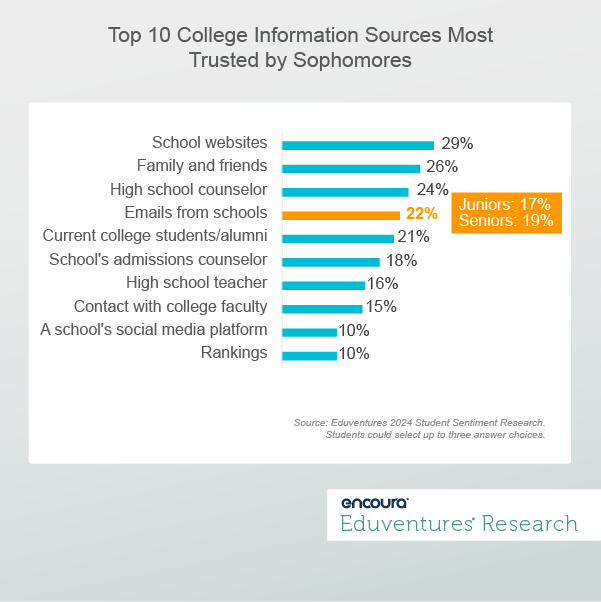Thirty-eight percent of all high school sophomores, according to Eduventures’ latest Student Sentiment Research™, report they became aware of a college by receiving an email from the school. This indicates that many institutions have discovered the benefits of engaging prospects early.
Yet, many struggling institutions, largely concerned with making the next class, don’t find the bandwidth to include sophomores in their outreach strategies. While survival mode often focuses our attention on the most critical task at hand, forgoing the potential to engage prospects early comes with a large opportunity cost.
Students have not only come to expect institutional outreach through email, but often rate it among the best sources of information throughout search. Receiving an email is the second-most common way for prospects to become aware of a college or university, after talking to family and friends.
But is it too early to reach out to high school sophomores with your email campaigns? Will they even pay enough attention to remember your institution’s name?
Eduventures’ Student Sentiment Research provides three reasons for including sophomores in these campaigns.
Reason #1. They’re (Extra) Excited To Hear From You
Sophomores are still years away from making important application and enrollment decisions, but that does not mean they are not already thinking about college. Among the sophomores in our research – whose demographic profiles do not differ significantly from their older peers - 52% have explored an institution’s website, and 52% have also read about an institution on a college planning site.
And they don’t yet receive nearly as much outreach as juniors and—especially—seniors. This means they are more likely to be excited to hear from you. Some sophomores shared the following comments:
- “I was already interested in the school and was excited to see an email from them.”
- “There may be some colleges out there who do not communicate with me and may need tips to improve their communication.”
- “It doesn’t matter (what they send) I just take anything I see.”
One thing to keep in mind, however, is that despite their excitement, they expect to take things slowly, take their time to get to know you, and don’t want to feel pressured to engage. Remember, most are still searching in stealth mode.
This process is not unlike online dating: You want to highlight your strengths and show interest without appearing too desperate, and get to know each other better before moving to the next step. In their words:
- “I feel as if they should give more information instead of just saying ‘We would like you to visit!’”
- “Give me actual information and realize I'm a sophomore.”
- “I don't need you to send me like three emails a day that makes you seem annoying.”
Reason #2. They Prefer Emails
Though some may argue that email is an archaic form of communication where traditional-aged students are concerned, it is still one of the best tools in your communications toolbox – at least for now. Convenient and unintrusive – because they don’t require immediate attention or response – students collect them in their inboxes to read at their convenience. And sophomores prefer this channel to others for direct outreach (Figure 1).
Figure 1.
Figure 1 highlights that at least half of sophomores prefer to receive emails from institutions to learn about important topics, especially career preparation, general information, and the application process.
It is also noteworthy that print and texting appear to be competing for second place. But print campaigns, which are preferred by no more than 20% of sophomores, are a costly form of outreach. Even more reason to prioritize email for sophomores – email campaigns offer a low-cost, low-risk strategy that can bring a high return.
Reason #3. They Trust Your Emails
Not only do sophomores prefer to receive emails to many other channels, but they also rank emails among the top five most trusted sources in college search (out of a list of 21 information sources). Figure 2 displays the top 10 most trusted sources for information about college according to sophomores.
Figure 2.
Among institutional sources, only the website (29%) is more trusted by sophomores than emails. We also see that sophomores reported higher trust in emails (22%) compared to juniors (17%) and seniors (19%). Juniors ranked emails fifth for trust, and seniors placed it sixth (not pictured above). This indicates a declining impact of emails as students move through the funnel, further emphasizing the importance of early outreach.
This does not necessarily mean that older students inherently mistrust the emails they receive from institutions, but rather that other sources rise in trust for them—for example, high school counselors, current and former students, and family and friends. Juniors and seniors seem to be more likely to verify your institutional narrative by talking to trusted individuals. Sophomores, on the other hand, are more likely to take your email at face value.
The Bottom Line
Many sophomores actively research prospective colleges, albeit under the radar, and they are already receiving emails from some colleges. Many other institutions still ignore sophomores in favor of getting the attention of high school seniors. But seniors are often overwhelmed with institutional outreach and often pay attention only to institutions with whom they have an established relationship.
Ideally, this initial connection should be forged when students are just starting to think about college and the relationship has time to blossom. Including sophomores in your email campaigns provides an effective and scalable tactic for early prospect cultivation. It does not have to be time-consuming or expensive.
Consider the following strategies:
- Include sophomores in some of your initial campaigns. In many cases it may not be effective to create frequent, sophomore-specific email campaigns, but you can include them in your initial campaigns to juniors and seniors. But be strategic about when to include them; don’t overcommunicate at this early stage.
- Understand what sophomores want to know. Relatedly, email sophomores when you have something to say that is of interest to them. Eduventures data shows that sophomores are most curious about value considerations (like cost and job outcomes) but also the academic experience. As you collect sophomore contacts, be sure those include the students’ academic interests and other relevant information like their Prospective Student Mindsets™.
- Let sophomores get to know you. The call-to-action in sophomore email campaigns should not include prompts to apply, for obvious reasons. But also, don’t push them too hard to inquire—many of these students prefer to remain in stealth mode. Rather, invite them to explore your institution, guiding them to other marketing channels like your website, social platforms, and digital ads.




